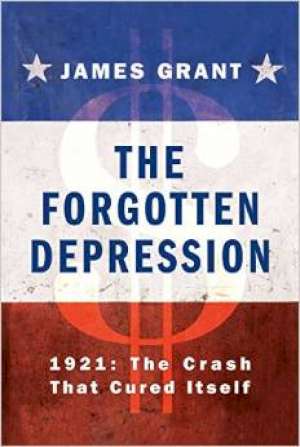01 April 2015
The Forgotten Depression - 1921: The Crash that Cured Itself
James Grant
2014, Simon and Schuster, 254 pages, £18.83
ISBN 9781451686456
Reviewer: Bill Allen

The title of this book seems strange. The basic facts of the boom and bust that followed the end of the First World War are well known and have been widely analysed by many distinguished economists including Milton Friedman and Anna Schwartz, Allan Meltzer, and Christina Romer. However, a reading of the Preface helps the reader to understand why Mr. Grant chose this title. He wants to make the case that the boom and bust of 1919-21 was successfully cured by official inaction, and that a bit more official inaction would have been very welcome in the recent financial crisis. If the world had remembered the story of 1919-21 more vividly, and if Ben Bernanke had published a book about 1919-21 instead of the one he did publish about the Depression of the 1930s, the world would now be a better place.
This reviewer is not convinced. The bulk of the book is a narrative, which takes the form of a more or less chronological series of anecdotes, about people such as W. P. G. Harding, the Chairman of the Federal Reserve (established less than a decade earlier), Benjamin Strong, Governor of the Federal Reserve Bank of New York, John Williams, the Comptroller of the Currency, President W. G. Harding (not to be confused with W. P. G.), and Andrew Mellon, the Secretary of the Treasury; and about companies like National City Bank, Morgan Guaranty Trust, and U.S. Steel. Entertaining though they generally are, they do not add up to a coherent argument, and are not accompanied by graphs or tables of figures. Moreover they sometimes leave a suspicion that they have been embroidered - for example, in describing Professor Irving Fisher, who died in 1947, Mr. Grant says that ‘a glance at his burning eyes suggested a ferocious intelligence’ (p.28). How does he know?
Unfortunately, the narrative contains a large number of factual errors. For example, readers are told that the failure of Overend Gurney in 1866 ‘elicited a helping hand from the Bank of England’ (p.27). But Overend Gurney wasn’t rescued. It was allowed to fail, and the resulting financial distress reinforced the pressure for the Bank of England to be more active as a lender of last resort: Bagehot’s famous Lombard Street appeared in 1873. And it isn’t true that ‘the war disposed of the international gold standard as cleanly as it did czarist Russia’: the gold standard lingered painfully on until 1936, by which time the Czar and his family had been long in their graves. For another example, contrary to what is suggested on pp. 29-30, the City of Glasgow Bank didn’t fail its depositors in 1878; its unfortunate shareholders bore the heavy burden of its mismanagement. Nor is it accurate to say that ‘Before the war, it went without saying that no central bank should go buying up the debt of its own government.’ (p. 50). That’s what the Bank of England was set up for in 1694 and it did so right up to and after 1914.
Worse still, some of the evidence that Mr. Grant presents to his readers undermines his own case, by showing that in fact, the Federal authorities did in fact provide extensive support to the banking system. For example, in chapter 6, Mr. Grant recounts how the Comptroller of the Currency discovered that National City Bank was in a seriously unsound financial condition in 1920. It had cash and unpledged government securities of only just over $9 million against deposits of $500 million, and bad loans of $40 million. It must have been doubtful whether the bank was solvent. Yet it remained in operation and went on borrowing from the Federal Reserve. By contrast, in 2008, the Fed declined to lend money to Lehman Brothers because they thought it was insolvent. Federal support was in this respect more liberal in 1920 than in 2008.
All this leaves me with a feeling that the conclusion was written first and the supporting material added later. Yet, despite this, the conclusion cannot just be dismissed out of hand. The facts of the recent financial crisis and the measures taken to deal with it make it clear that something went badly wrong and that things could not go on as they were. What went wrong? Was it just that the authorities panicked unnecessarily, and overreacted, as Mr. Grant suggests? Whatever you make of 1919-21, the bitter experience of 1931 and after strongly suggests that the authorities were not wrong in supporting banks and in allowing large budget deficits to emerge after 2008. The official answer to the ‘what went wrong?’ question has been that banks were much too loosely regulated before 2008, and the recent avalanche of new regulation is the result. There is scope for doubt whether it is the best possible result, and for anxiety about the economic effects of the avalanche. But Mr. Grant does not convince me that letting the banks fail would have been a better idea.
